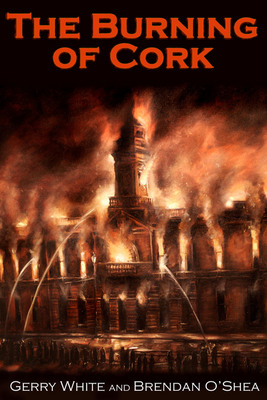The Burning of Cork
Peter Berresford Ellis reviews The Burning of Cork by Gerry White and Brendan O'Shea, published by Mercier Press, ISBN 1-85635-522-5, £10.65 pbk

IN REVIEWING this book, I have to start out by declaring an interest. One of the principle sources for it is my father's eyewitness account of the burning of the city centre in December, 1920, by British troops. He was a reporter on the Cork Examiner and used the reports he wrote for the newspaper and for the Irish Bulletin, which, unbeknown to his employers, he was also writing for, to write an account in the 1930s which the Aubane Historical Society of Cork recently republished it.
White and O'Shea have written a brilliant account that holds one like a thriller. Although I heard the story at firsthand from my father and subsequently read his account, there is much in this book that I did not know, accounts from other sources that support and expand his personal story.
This is an essential book and one that corrects the neo-colonial propaganda about Cork turned out by the likes of Peter Hart.
The night of 11 December 1920, was one that had left an indelible mark on Cork history - in spite of being dismissed in one sentence in Hart's book supposedly devoted to the 'Violence and Community in Cork 1916-23' (his subtitle).
Attacks on the occupying forces by the Irish Volunteers were being answered by bloody reprisals, not only by the notorious 'Black and Tans' and the infamous 'Auxiliaries' but even by regular regiments such as the Essex Regiment, well known for their outrageous behaviour in Cork under Major A.E. Percival (later the British general who surrendered to the Japanese in Singapore).
But of all the terror raids, such as the burning of Trim, where 25 per cent of the houses were burnt, Mallow, Balbriggan, Ballinalee and many other places, the burning of Cork City was the worst single atrocity carried out by British troops to terrorise the populace into submission.
Scrupulously researched and footnoted, the authors track down the events leading to and through the night which was one of unprecedented horror. They continue to the aftermath, showing how the British government tried to claim that it was the citizens of Cork who set fire to their own city and then, in the face of international media attention, suppressed the results of the inquiry they were forced to hold.
The authors come to the conclusion that the leading unit in this atrocity was the 100 men of K Coy, Auxiliary Division of the RIC. The Auxiliaries were mainly recruited from among the demobilised officers of the British army, those having served in the 1914-18 War, and organised in July, 1920. They were paid £1 per day plus expenses making them the highest paid uniformed force of their time. They were also allowed three months paid leave. They were called 'police cadets' for propaganda purposes.
While the 'Black and Tans' have become a by-word for brutality, in fact, it was the 'Auxies' who were infamous for their ferocity, reprisals and murders.
This book is a history, and also a thriller, it's compulsive reading - this book is a must.
Connolly Association, c/o RMT, Unity House, 39 Chalton Street, London, NW1 1JD
Copyright © 2007 Peter Berresford Ellis

